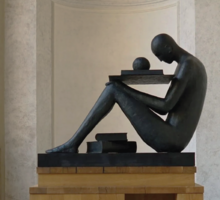

You can help expand this article with text translated from the corresponding article in Italian. (October 2023) Click [show] for important translation instructions.
|topic= will aid in categorization.Content in this edit is translated from the existing Italian Wikipedia article at [[:it:Enciclopedia Treccani]]; see its history for attribution.{{Translated|it|Enciclopedia Treccani}} to the talk page. |
The Institute of the Italian Encyclopaedia | |
Istituto della Enciclopedia Italiana Treccani
| |
 | |
| Formation | 1925 |
|---|---|
| Founders | Giovanni Treccani and Giovanni Gentile |
| Headquarters | Rome, Italy |
President | Franco Gallo |
General Manager | Massimo Bray |
| Website | www |
| This article is part of the series on the |
| Italian language |
|---|
| History |
| Literature and other |
| Grammar |
| Alphabet |
| Phonology |
|
|
The Institute of the Italian Encyclopedia Treccani (Italian: Istituto della Enciclopedia Italiana Treccani), also known as the Treccani Institute, is a cultural institution of national interest, active in the publishing field, founded by Giovanni Treccani in 1925.[1][2]
It is renowned for publishing the first edition and the subsequent ten supplements of the Italian Encyclopedia of Science, Literature and Arts (Italian: Enciclopedia Italiana di scienze, lettere ed arti), considered one of the most important encyclopedias of the 20th century, alongside the Encyclopædia Britannica and the Enciclopedia universal ilustrada europeo-americana.[1][2][3]
The Institute of the Italian Encyclopedia was founded in Rome in 1925 by Giovanni Treccani, with the philosopher Giovanni Gentile as editor-in-chief.
The first publication by the Institute was the Enciclopedia Italiana di Scienze, Lettere e Arti (Italian: "Italian Encyclopedia of Science, Letters, and Arts"). This encyclopedia, best known as Enciclopedia Italiana or the Great Encyclopaedia, is an Italian-language encyclopaedia and is regarded as one of the great encyclopedias, being international in scope, alongside Encyclopædia Britannica and others.[4]
Since the 1990’s Treccani has been playing a leading role as a high profile publisher, both in the art publishing market and in the facsimile editions industry, reproducing many medieval manuscripts from the most prestigious italian and european libraries.
Alongside these traditional activities Treccani has gained a consistent presence in digital publishing, with the publication of e-books, apps and, above all, the www.treccani.it portal, which has been visited, in 2022, by more than 80 million unique users.
The first edition of the Great Encyclopaedia was published serially between 1929 and 1937.[1][5] The encyclopedia's 35 volumes (plus one index volume) included 60,000 articles and 50 million words.[6] Each volume is approximately 1,015 pages, and supplementary volumes were published between 1938 and 2020.
10th Appendix
An update to the Great Encyclopaedia: a reflection by Treccani on contemporaneity. Its challenges and problematic issues are analyzed in a language of great clarity and readability through over 350 keywords assigned to authors of the highest scientific profile and to young scholars who have now established themselves at the international level.[1][7]
Biographical Dictionary of Italians
A monumental national biography reconstructed through over forty thousand biographies of Italians who have contributed to the artistic, cultural, political, scientific, religious, literary and economic history of the country, from the fall of the Western Roman Empire to the present day.
Contemporary art
A work in 4 volumes edited by Vincenzo Trione and Valeria Della Valle, supported by an international scientific committee: a survey of the art of our time, with the aim of documenting, in the broadest and most inclusive perspective, the various components that make up the system of art throughout the world. The work catalogues not only the artists, but also the art historians, the critics and the curators, the gallerists, the merchants and dealers.
Italian Enterprise
In two volumes, edited by Franco Amatori and Marco D’Alberti, it recounts the most significant entrepreneurial, technological and scientific developments in the history of our country. “The Stories”, with its wide selection of biographies of the most representative industrial enterprises, aims to provide a picture of Italian companies in their great variety of size, territory, sector, and governance. “The Context” frames thematic essays that recount the eventful history of the Italian enterprise in its complex operating context, in its relationship with institutions and politics, in the competitive scene of globalization.
Fac-simile reproductions
Fac-simile reproductions of illuminated manuscripts kept in the most important European libraries contributes to the conservation and diffusion of an immense common artistic and literary heritage. The latest publications are that of the magnificent code preserved in Florence in the Laurentian Library, with the signature Plut. 6.23 an 11th-12th century Gospel book, accompanied by a systematic illustrative apparatus. The 237 folios contain 285 illustrations: as Tania Velmans defines it in the essay published in the volume accompanying the facsimile (Il Tetravangelo della Laurenziana, Florence, Laur. Plut. 6.23, 2020), it really is «an almost unique specimen for the abundance of his illustrations, fidelity to the evangelical texts, the will to reconstruct the evangelical story through the image, in an almost integral way» (p. 36).
| International |
|
|---|---|
| National |
|
| Other |
|